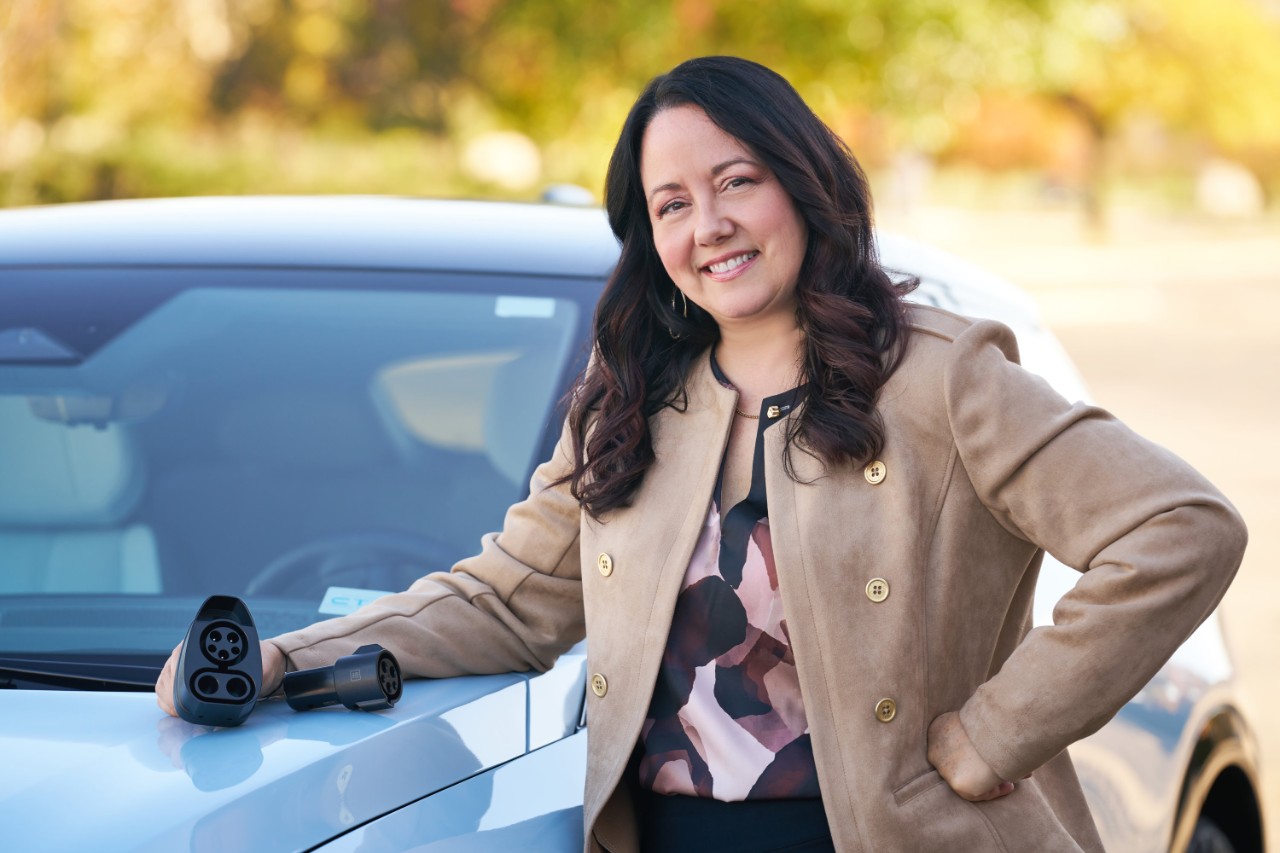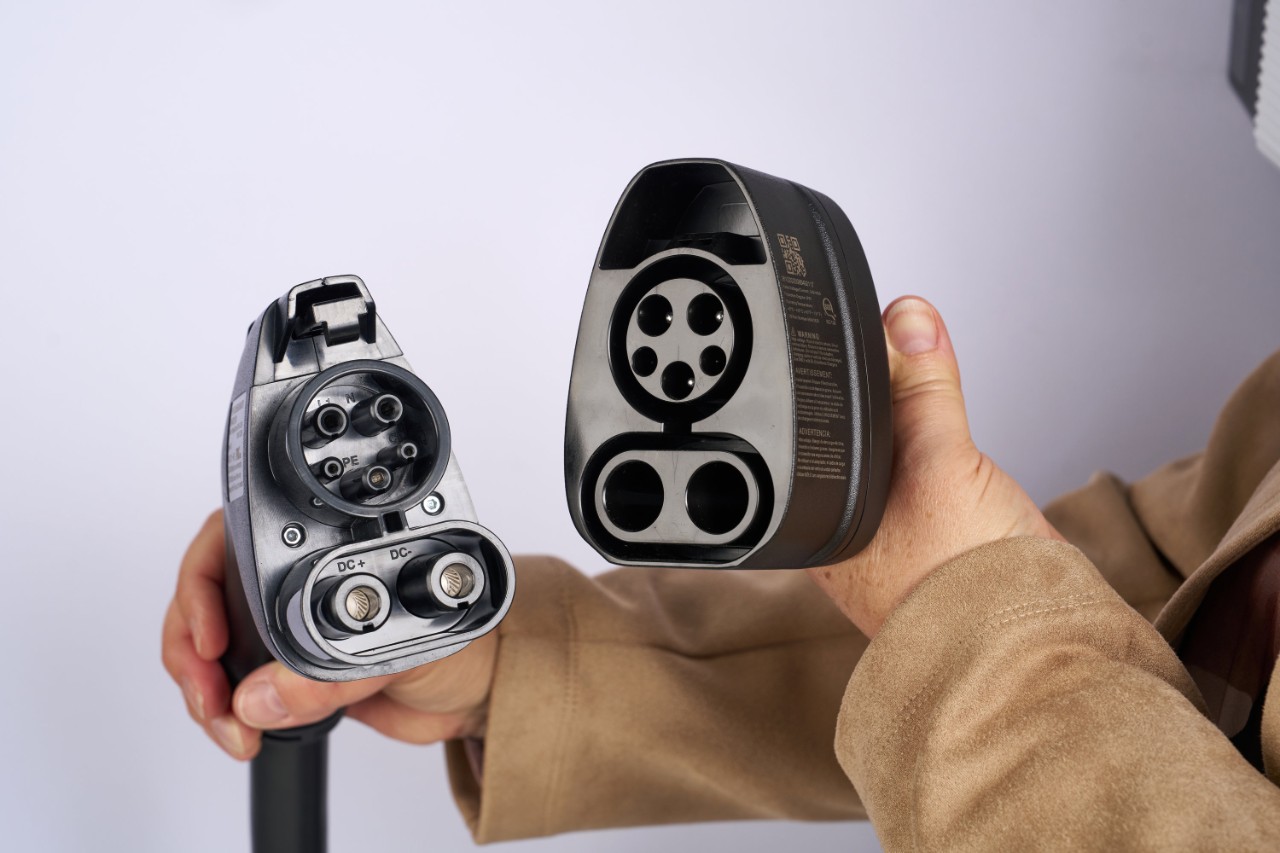By Rita Kass-Shamoun, GM Communications
GM is making a major step toward simple, universal EV charging by moving to a NACS standard. And integral to the transition is veteran engineer Sandra Monterosso, whose expertise is helping make charging easier and more accessible.
Sandra leads the development of EV charging products, including the recently launched adapters that connect CCS and NACS standards, allowing drivers to charge at more stations, helping to reduce charging anxiety. But this shift is more than just plugs and adapters; it’s about supporting customers, simplifying the charging experience, and expanding access.
We spoke with Sandra about her journey, her role in the NACS transition, and what’s next.
Sandra, how did your journey at GM begin?
I joined GM right out of high school as a GMI [General Motors Institute, now Kettering University] co-op student, inspired by a family friend. Over the years, I’ve taken on roles in chassis, seats, battery development, and electrification. My current role as the NACS transition program engineering manager is the highlight of my career — I get to solve real customer problems while driving execution across teams.
What excites you most about working in EVs and charging?
We’re doing more than building new vehicles; we’re helping people feel confident about going electric. That means removing barriers, reducing anxiety, and delivering on what customers expect. Driving an EV myself made it click for me — the torque, the smoothness , the efficiency. Once you experience it, you’re hooked.
What were the steps to make native NACS a reality?
We launched a cross-functional “mega study” to map out every stakeholder and deliverable, from hardware and software to customer logistics and mobile apps. In a year, we collaborated across vehicle programs and engineering operations, upgraded infrastructure to support incoming NACS vehicles, worked with new suppliers, and navigated emerging certification standards. It was a full-court press.
Caption: General Motors Program Engineering Manager Sandra Monterosso holds a charging cable and adapter.
What was your first “we’ve got this” moment?
Holding the first finished GM NACS DC adapter in my hand. That was our gateway to thousands of fast chargers — a major step toward reducing range anxiety and improving customer experience. Soon, messages started pouring in from colleagues and customers. People were genuinely excited. That’s when it hit me: this was real, and it was resonating.
What’s the biggest misconception about adapters or NACS?
That the adapters are afterthoughts, which isn’t the case. We put our adapters through our rigorous testing and validation to meet our safety and durability standards. The adapters were validated for every GM EV, and tested against many different real-world scenarios — rain, snow, heat, impacts, and even being driven over.
What keeps you motivated through all the complexity?
Helping others. I’m at my best when supporting others through tough moments. I guide, listen, and share – because growth doesn’t happen alone. Through it all, I stay focused on what matters most: helping make the EVs better and charging easier for everyone to access.
Any advice for others working on first-of-their-kind projects?
Growth happens outside your comfort zone. Embrace change, challenge assumptions, and don’t wait for someone else to lead. As the saying goes, “comfort and growth don’t coexist.” Be the one who grows.

General Motor’s move to adopt the North American Charging Standard, or NACS, for its electric vehicles marks a major step toward simple, universal EV charging. Integral to the transition to a unified charging standard is veteran GM engineer Sandra Monterosso, whose expertise is helping make charging easier and more accessible.
Monterosso leads the development of GM’s EV charging products, including recently-launched adapters that connect the CCS and NACS standards, allowing which drivers to charge at more stations, reducing charging anxiety. This shift is about more than just plugs and adapters; it’s about supporting customers, simplifying the charging experience, and expanding access.
We spoke with Monterosso about her journey, her role in the NACS transition, and what’s next.
How did your journey at GM begin?
I joined GM right out of high school as a GMI [General Motors Institute, now Kettering University] co-op student, inspired by a family friend. Over the years, I’ve taken on roles in chassis, seats, battery development, and electrification. I’ve been lucky to grow in ways that set me up for this moment. My current role as the NACS transition program engineering manager is the highlight of my career — I get to solve real customer problems while driving execution across teams.
What excites you most about working in the EV and charging space?
We’re doing more than building new vehicles; we’re helping people feel confident about going electric. That means removing barriers, reducing anxiety, and delivering on customers’ expectations. Driving an EV myself made it click for me — the torque, the smoothness, the efficiency. Once you experience it, you’re hooked.
What were the steps to make native NACS a reality?
We launched a cross-functional “mega study” to map out every stakeholder and deliverable, from hardware and software to customer logistics and mobile apps. In a year, we collaborated across vehicle programs and engineering operations, upgraded infrastructure to support incoming NACS vehicles, worked with new suppliers, and navigated emerging certification standards. It was a full-court press.

What was your first “we’ve got this” moment?
Holding the first finished GM NACS DC adapter in my hand. That was our gateway to thousands of fast chargers — a major step toward reducing range anxiety and improving customer experience. Soon, messages started pouring in from colleagues and customers. People were genuinely excited. That’s when it hit me: this was real, and it was resonating.
What’s the biggest misconception about adapters or NACS?
That the adapters are afterthoughts, which isn’t the case. We put our adapters through our rigorous testing and validation to meet our safety and durability standards. The adapters were validated for every GM EV, and tested against many different real-world scenarios — rain, snow, heat, impacts, and even being driven over.
What keeps you motivated through all the complexity?
Helping others. I’m at my best when supporting others through tough moments. I guide, listen, and share – because growth doesn’t happen alone. Through it all, I stay focused on what matters most: helping make our EVs better and charging easier for everyone to access.
Any advice for others working on first-of-their-kind projects?
Growth happens outside your comfort zone. Embrace change, challenge assumptions, and don’t wait for someone else to lead. As the saying goes, “Comfort and growth don’t coexist.” Be the one who grows.
Thanks, Sandra!
Rita Kass-Shamoun is part of the General Motors communications team.
Questions or comments: news@gm.com